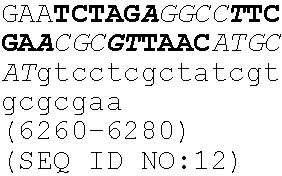Highly infectious rubella virus DNA constructs and methods of production
a rubella virus and construct technology, applied in the field of molecular virology, can solve the problem of inability to produce highly infectious rubella virus clones, and achieve the effect of improving stability
- Summary
- Abstract
- Description
- Claims
- Application Information
AI Technical Summary
Benefits of technology
Problems solved by technology
Method used
Image
Examples
example 1
Preparation of f-Therien Virion RNA and RT-long PCR
[0090]Vero cells (ATCC, Rockville, Md.) were infected with f-Therien rubella virus (multiplicity of infection (m.o.i.)=0.5). Four days post infection, culture medium was harvested and PEG-precipitated virion RNA was isolated using either TRI-Reagent LS (Molecular Research Center, Cincinnati, Ohio), according to the protocol provided by the manufacturer, or by using the method described by Wang, C. Y. et al., J. Virol. 68:3550-3557 (1994). The extracted RNA was further purified by oligo-(dT)-cellulose chromatography, redissolved in 50 μl of water, and stored at −70° C.
[0091]First strand cDNA synthesis was performed with AMV reverse transcriptase (RiboClone™ cDNA Synthesis Kit; Promega, Madison, Wis.), according to the protocol provided by the manufacturer, in the presence of sodium pyrophosphate with one of the following three primers:[0092]SEQ ID NO:4:[0093]5′-GGGAAGCTTGCACGACACGGACAAAAGCC
(underlined sequence is complementary to nuc...
example 2
Construction and Specific Infectivity of Robo202
[0107]The specific infectivity of the rubella virus cDNA clone designated Robo202, as described above in Example 1, was determined as follows. After PCR amplification of fragment III (SEQ ID NO:10), as described above, the fragment was digested with restriction enzymes BglII and EcoRI and ligated with a similarly digested Robo102 clone, as shown in FIG. 1. In vitro transcription of the newly constructed clone, Robo202, and subsequent transfection into Vero cells resulted a 104-fold increase in infectivity. While the slightly infectious Robo102 clone did not induce cytopathic effects within eight days after transfection into Vero cells, insertion of fragment III into the Robo102 clone resulted in cytopathic effects within five days of transfection into Vero cells. However, insertion of either fragment I (SEQ ID NO:2) or fragment II (SEQ ID NO:3) produced viral transcripts, and therefore the mutation that caused low infectivity of Robo10...
example 3
Construction and Specific Infectivity of Robo302
[0108]Following PCR amplification of fragments I (SEQ ID NO:2) and II (SEQ ID NO:3), the fragments were digested with restriction enzymes HindIII and KpnI, and NheI and BglII, respectively. The fragments were simultaneously inserted into a Robo202 clone wherein the corresponding fragments had been removed, resulting in the Robo302 construct, as shown in FIG. 1. The addition of fragments I (SEQ ID NO:2) and II (SEQ ID NO:3) to the Robo202 construct, produced viral transcripts with an increased specific infectivity.
[0109]Vero cells grown in 24-well plates were infected with the indicated viruses at an m.o.i. of 2 pfu / cell. At indicated times post infection, cells were trypsinized, washed with PBS and stained with trypan blue. Three aliquots of each trypsinized cell suspension were counted. As shown in FIG. 2, viral transcripts derived from the Robo302 clone induced approximately 80% cell death over the control, whereas viral transcripts ...
PUM
| Property | Measurement | Unit |
|---|---|---|
| MW | aaaaa | aaaaa |
| MW | aaaaa | aaaaa |
| MW | aaaaa | aaaaa |
Abstract
Description
Claims
Application Information
 Login to View More
Login to View More - R&D
- Intellectual Property
- Life Sciences
- Materials
- Tech Scout
- Unparalleled Data Quality
- Higher Quality Content
- 60% Fewer Hallucinations
Browse by: Latest US Patents, China's latest patents, Technical Efficacy Thesaurus, Application Domain, Technology Topic, Popular Technical Reports.
© 2025 PatSnap. All rights reserved.Legal|Privacy policy|Modern Slavery Act Transparency Statement|Sitemap|About US| Contact US: help@patsnap.com



